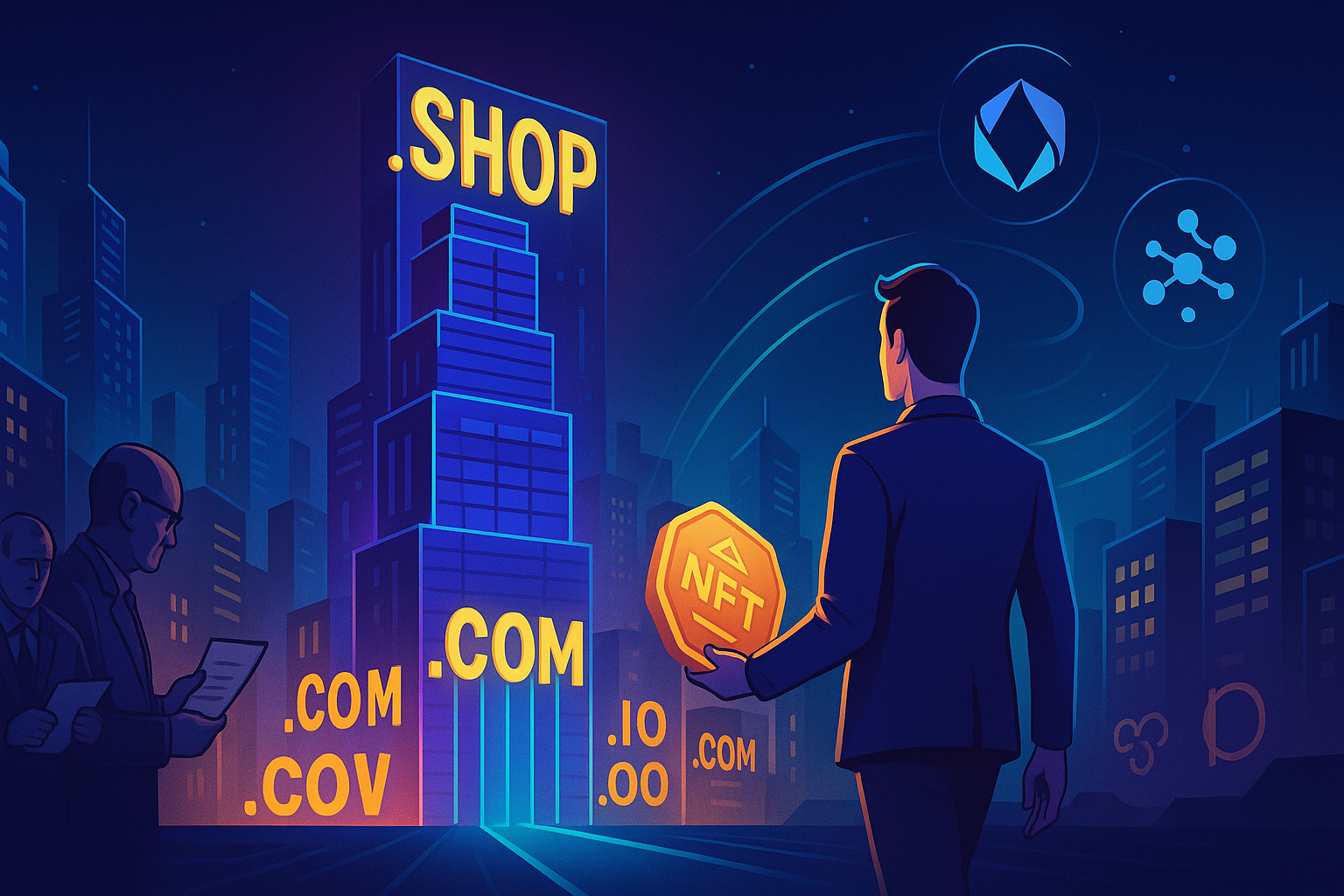The Digital Property We Overlook
When we talk about “real estate,” most people imagine land, buildings, and property. But on the Internet, domain names are prime property. They anchor identity, access, and branding, and yet, surprisingly, the domain market lags far behind in liquidity, innovation, and financial infrastructure.
While tokenization is sweeping real-world assets, the $10 billion premium domain niche still relies on Web2’s archaic trading model. It can take months to sell, commissions run high, and fractional ownership is nearly unheard of. Meanwhile, elsewhere in RWA (real-world asset) arenas, smart contracts, fractional shares, and 24/7 markets are rewriting how value moves.
It’s not just inefficiency. It’s a danger: the domain space is at risk of being displaced by naming systems designed for Web3, like ENS, which were built with liquidity and composability baked in.
Tokenization: Why It’s Essential Now
Tokenization, turning ownership into blockchain-native fragments, has transformed many sectors. Governments, real estate, art, even treasury assets: they’re now tradable, divisible, and borderless. This evolution brings transparency, fractional access, and instant settlement.
Yet domains, a pure digital asset by nature, remain stuck. Why? Because domain transfers are slow, escrow-heavy, service-dependent, and commission-laden. The paradox is jarring: the internet’s most virtual real estate trades slower than physical property in many cases.
With tokenization, domains could become fractional, liquid, and integrated with DeFi. They’d trade instantly, move across chains, and participate in loans, collateral, or decentralized governance. The infrastructure is largely there; what’s missing is adoption and standardization.
Inside the Antiquated Domain Economy
Selling a domain today often means contacting brokers, negotiating offline, waiting weeks or months, paying heavy commissions (15–30%), and dealing with escrow. That’s even for premium names like “organic.shop.”
Even more surprising: less than 1% of registered domains trade annually. For an asset class with 360 million+ registrations and a premium segment worth $10 billion, that’s a strikingly low turnover. That implies billions of value may remain locked, inaccessible, or underexploited.
The issue is not lack of interest; it’s friction. Payment rails, legal frameworks, credit lines, and fractional sales—all these functions operate smoothly in tokenized arenas. Domains lag because they haven’t adapted.
How the Tokenization Shift Could Unfold
Transforming domains into tokenized assets involves several steps:
Domain → NFT: Convert domain ownership into a standard NFT, while preserving the ICANN legal structure.
Fractionalization: Break the NFT into smaller tokens, enabling partial ownership.
Cross-chain liquidity: Allow these fractional positions to flow across networks (Ethereum, Solana, etc.).
Governance & voting: Enable owners to vote on domain usage or collective development.
DeFi layering: Use domain tokens as collateral, stake for incentives, or bundle into index products.
Once that infrastructure sits in place, domain marketplaces become as fluid as stock markets: liquid, global, and composable.
The Threat (and Opportunity) from ENS & Web3 Names
Web3 naming systems like ENS (Ethereum Name Service) are gaining traction because they solve liquidity problems out of the box. ENS names map directly to addresses, are native to the blockchain, and many already trade across platforms.
The risk: if traditional domain registrars don’t adapt, they may cede dominance. Innovators that embrace tokenization quickly could attract premium assets hungry for liquidity. Legacy domain players that resist could be sidelined by ecosystems built from the ground up with composability and finance in mind.
Challenges Ahead: Legal, Technical, and Cultural
The domain space isn’t moving alone into tokenization. Several challenges must be addressed:
Regulation & ownership: Domain rights are often tied to registry contracts, ICANN rules, and local laws. Tokenization must respect these legal overlays.
Standardization: Protocols, metadata, and fractional structures all need standards so that tokens interoperate across platforms.
Dispute resolution: Domain disputes (trademarks, transfers, renewals) require mechanisms akin to arbitration even in a tokenized model.
User experience: Domain holders expect simplicity; NFT wallets, gas fees, and blockchain UX must be seamless or hidden.
Onboarding legacy assets: Domains already owned, locked, or under long-term registration require pathways to convert to blockchain without significant disruption.
Technically and legally complex, yes, but the upside is huge.
Why Now Is the Right Moment
Three forces align to push domain tokenization forward:
RWA infrastructure maturity: Tokenizing real estate, art, and financial assets is now mainstream.
Demand for liquidity: Capital wants assets that move freely; domains are a glaring outlier.
Blockchain-native identity: As Web3 grows, domains should integrate with other identity and naming layers, not stay siloed.
Tokenization might begin in premium domain niches, then expand into subdomains, renewals, rentals, and every aspect of the domain lifecycle.
Who Wins and Who Loses
Winners: Early mover registrars, marketplaces, and platforms that adopt tokenization first. They gain network effects, liquidity, and market inertia.
Winners: Domain owners who gain easier exit paths, fractional monetization, and financial utility.
Losers: Entities that cling to broker-heavy, slow models. Their assets may lose relative value as liquidity-rich alternatives emerge.
Losers: Markets with regulatory inertia that block tokenization or innovation may lose digital territory to more agile jurisdictions.
The Inevitable Transition
This is less revolution and more evolution. The tools exist. Demand is proven. The question now is speed and execution. The first registrars and platforms that tokenize domains well will attract premium domains and liquidity and position themselves as the new “real estate” moguls of the internet.
Those who wait risk being displaced by naming systems born with finance built in.

